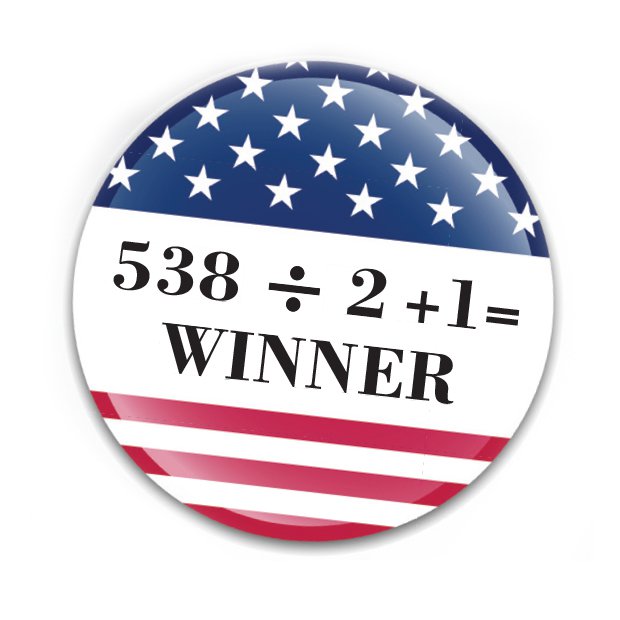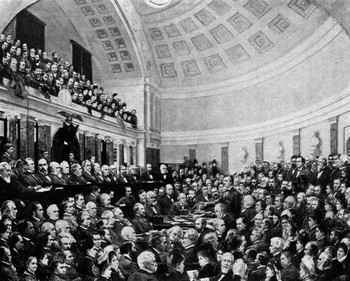The 'Faithless Electors' of the Electoral Process
Article II of the Constitution lists the specifics of the Electoral College. Each state sends a number of electors to that state's capital, for a special meeting that, technically, elects the President; however, the requirements of those electors as to how to proceed at that meeting varies by state.
The other 21 states do not have such requirements of their electors; so, technically, those electors can vote for whomever they want. Tradition, for the entire history of the United States, has been that electors vote as instructed. As well, the electors for each state are selected from within the political party of the candidate who got the most popular votes in that state. So a Republican nominee who wins a state has technically won the right to have that party's slate of electors go to the Electoral College. The states that bind their electors are these: If the final electoral vote does not significantly resemble the expected vote, based on the results on Election Day, then Congress has the power to challenge the results. Specifically, a member of the Senate or the House of Representatives can challenge the vote of his or her state; if that happens, then that state's votes are subject to review by both the House and the Senate, in separate deliberations. This has happened three times in American history: in 1872, in 2000, and in 2004. The state electoral tallies of Arkansas and Louisiana in 1872 were objected to and then thrown out, after congressional deliberation; Ulysses S. Grant still won re-election. Objections in 2000 and 2004 did not result in any state's votes being removed from the overall total. Americans have voted in a total of 57 presidential elections. In all of those elections, fewer than 200 electors have voted other than as instructed.
In 1808, six electors appointed by the Democratic-Republican Party refused to vote for their party's presidential candidate, James Madison; instead, these six electors cast their presidential votes for George Clinton, their party's vice-presidential nominee. Madison still won the election handily. A similar thing happened four years later, when three Federalist Party electors cast their vice-presidential votes not for their party's vice-presidential candidate, Jared Ingersoll, but for Elbridge Gerry, the vice-presidential candidate for the opposing party, the Democratic-Republicans. The Federalists would not have won the election anyway; Madison clearly won re-election. James Monroe ran for re-election in 1820 and won a dominating victory, sweeping the popular vote in every state in the Union. When it came time for the electoral vote, one elector voted for John Quincy Adams, who had not run at all, for President or for Vice-president. The elector, New Hampshire's William Plummer, is said to have stated that no candidate other than George Washington should be elected with a unanimous electoral vote. Three other electors did not vote at all. Eight years later, Andrew Jackson was elected President and his running mate, John C. Calhoun, elected Vice-president, despite seven of the nine Georgia electors voting not for Calhoun, but for another candidate, William Smith. The 1832 electoral vote featured two abnormalities: Two Maryland electors from Henry Clay's National Republican Party refused to vote for Clay and, in fact, did not vote at all; also, a full 30 electors from Pennsylvania voted not for Andrew Jackson's running mate, Martin van Buren, but for William Wilkins. Neither abnormality affected the overall outcome, which was a dominant re-election win for Jackson. The Senate provided the means of election for Vice-president in 1836. Martin van Buren won the presidency. His running mate, Richard Johnson, lost the support of 23 electors from Virginia, who abstained from voting for Vice-president. The Senate voted, one-vote-per-state as instructed in the 12th Amendment, for Johnson as van Buren's Vice-president. The Democratic Party's 1872 presidential nominee, Horace Greeley, lost the election but still won electoral votes. Greeley died before the electoral meetings took place, and 63 of the 66 Democratic Party electors did not want to vote for a candidate who was no longer living. Of the 63, 17 abstained from voting; the other 43 voted for one of three candidates. The election, however, was a clear-cut re-election for Ulysses S. Grant. One of the Democratic Party's most well-known nominees in the late 19th Century, William Jennings Bryan, was also the nominee of the People's Party in 1896. Bryan's Democratic running mate was Arthur Sewall; the People's Party nominated Thomas Watson for Vice-president. Of the 31 electoral votes that the People's Party garnered, four electors voted for the Democratic ticket, supporting Sewall as Vice-president. Another death affected the electoral vote in 1912. William Howard Taft was running for re-election, and his running mate was James Sherman, who died before the election. Eight Republican electors voted not for Sherman but for Nicholas Butler. A Southern Democrat ticket in 1948, the so-called "Dixiecrat" ticket officially known as the States Rights Party, gained what should have been the votes of 39 electors but instead was 37 electoral votes because two electors did not vote as instructed; instead, both voted for the main Democratic Party nominee, Harry S. Truman (who won the election but by more than two votes). Adlai Stevenson, who twice ran against Dwight D. Eisenhower, received one fewer electoral vote in 1956 than he thought he was getting when an elector from Alabama voted for a judge from his hometown. The 1960 electoral vote featured a high-profile effort to change the expected outcome. A Republican elector from Oklahoma named Henry Irwin was instructed to vote for Richard Nixon, who had won the popular vote in Oklahoma; but Irwin did not want to vote for Nixon and sent a telegram to all of the other Republican electors, asking them to vote for another candidate entirely. Irwin did indeed vote for Senator Harry Byrd of Virginia (not Nixon), but Irwin did not lead a wholesale revolt. A total of 14 electors from states that did not require them to vote for their state's popular vote total winner followed Irwin's lead and voted for Byrd (while also voting for Democrat Senator Strom Thurmond for Vice-president). The defections did not affect the overall result, however, which was a victory for the Democratic Party candidate, John F. Kennedy. Nixon suffered another defection in 1968, when an elector from North Carolina cast his vote for George Wallace, who won five states and 46 electoral votes. Nixon, it turned out, did not need the defector's vote or even those that went to Wallace because the final electoral vote was a decisive win for Nixon. A third Nixon defection in 1972 resulted in a Virginia elector casting a vote for the Libertarian Party candidate, John Hospers. The same elector cast his vote for the Libertarians' vice-presidential candidate, Toni Nathan. (She became the first female candidate to receive an electoral vote.) The 1976 election featured a down-to-the-wire Republican primary campaign between the incumbent President, Gerald Ford, and California Governor Ronald Reagan. Ford won the nomination, but one elector from Washington cast his electoral vote for Reagan. That one vote, had it been cast for Ford, would not have been enough to propel him to victory. Democrat Jimmy Carter won the presidency. Another high-profile change of heart occurred in 1988. A West Virginia elector cast her presidential vote for Lloyd Bentsen, the Democratic Party's vice-presidential nominee, and her vice-presidential vote for Michael Dukakis, the presidential nominee. The result did not affect the overall outcome, which was a win for Republican George Bush. A District of Columbia elector abstained from voting in 2000, in the first such instance of abstinence from voting since 1832. The 2000 election was close, but the D.C. elector's refusing to vote did not affect the overall outcome, which was a victory for George W. Bush. The 2004 electoral vote featured a Minnesota elector's presidential vote for John Edwards, the vice-presidential nominee, instead of the presidential nominee, John Kerry. President George W. Bush won re-election, by more than 35 votes. |
|
Social Studies for Kids
copyright 2002–2024
David White



 The District of Columbia and 29 states effectively require their electors to vote for the political candidate who got the most popular votes in that state. The Supreme Court upheld the states' right to so require their electors in the 1952 case Ray v. Blair. Electors who do not vote as they have been instructed can be subject to fines and/or can be prosecuted for having committed a misdemeanour; such punishments, however, are rare.
The District of Columbia and 29 states effectively require their electors to vote for the political candidate who got the most popular votes in that state. The Supreme Court upheld the states' right to so require their electors in the 1952 case Ray v. Blair. Electors who do not vote as they have been instructed can be subject to fines and/or can be prosecuted for having committed a misdemeanour; such punishments, however, are rare. One Pennsylvania elector in 1796 chose not to vote for
One Pennsylvania elector in 1796 chose not to vote for 
